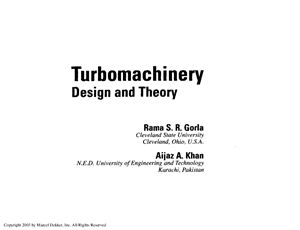Marcel Dekker, Inc., 2003. 397 р. ISBN:0-8247-0980-2.
Turbomachinery: Design and Theory offers an introduction to the subject ofturbomachinery and is intended to be a text for a single-semester course for seniorundergraduate and beginning graduate students in mechanical engineering,aerospace engineering, chemical engineering, design engineering, and manufacturing engineering. This book is also a valuable reference to practicingengineers in the fields of propulsion and turbomachinery. A basic knowledge of thermodynamics, fluid dynamics, and heat transfer is assumed. We have introduced the relevant concepts from these topics andreviewed them as applied to turbomachines in more detail. An introduction to dimensional analysis is included. We applied the basic principles to the study of hydraulic pumps, hydraulic turbines, centrifugal compressors and fans, axial flow compressors and fans, steam turbines, and axial flow and radial flow gas turbines. A brief discussion of cavitation in hydraulic machinery is presented. Each chapter includes a large number of solved illustrative and design example problems. An intuitive and systematic approach is used in the solution of these example problems, with particular attention to the proper use of units, which will help students understand the subject matter easily. In addition, we have provided several exercise problems at the end of each chapter, which will allow students to gain more experience. We urge students to take these exercise problems seriously: they are designed to help students fully grasp each topic and to lead them toward a more concrete understanding and mastery of the techniques presented.
Turbomachinery: Design and Theory offers an introduction to the subject ofturbomachinery and is intended to be a text for a single-semester course for seniorundergraduate and beginning graduate students in mechanical engineering,aerospace engineering, chemical engineering, design engineering, and manufacturing engineering. This book is also a valuable reference to practicingengineers in the fields of propulsion and turbomachinery. A basic knowledge of thermodynamics, fluid dynamics, and heat transfer is assumed. We have introduced the relevant concepts from these topics andreviewed them as applied to turbomachines in more detail. An introduction to dimensional analysis is included. We applied the basic principles to the study of hydraulic pumps, hydraulic turbines, centrifugal compressors and fans, axial flow compressors and fans, steam turbines, and axial flow and radial flow gas turbines. A brief discussion of cavitation in hydraulic machinery is presented. Each chapter includes a large number of solved illustrative and design example problems. An intuitive and systematic approach is used in the solution of these example problems, with particular attention to the proper use of units, which will help students understand the subject matter easily. In addition, we have provided several exercise problems at the end of each chapter, which will allow students to gain more experience. We urge students to take these exercise problems seriously: they are designed to help students fully grasp each topic and to lead them toward a more concrete understanding and mastery of the techniques presented.

